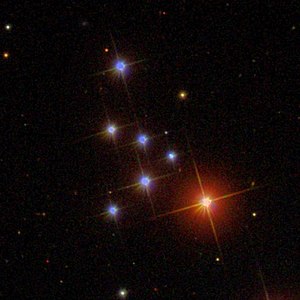NGC 7772

|
|
| SDSS recording | |
| AladinLite | |
| Constellation | Pegasus |
|
Position equinox : J2000.0 |
|
|---|---|
| Right ascension | 23 h 51 m 45.9 s |
| declination | + 16 ° 14 ′ 53 ″ |
| Appearance
|
|
| classification | III1p |
| Angular expansion | 5 ', core 2' |
| Number of stars | 14th |
| Brightest star | +11.18 mag |
| Redness ( excess color E (BV)) | approx. 0.03 mag |
| Physical data
|
|
| Affiliation | Milky Way |
| distance | 4900 ly (1500 pc ) |
| Age | about 1.5 billion years years |
| history | |
| Discovered by | John Herschel |
| Discovery time | October 7, 1825 |
| Catalog names | |
| NGC 7772 • C 2349 + 159 • OCl 230 • Lund 1049 • GC 5023 • h 2276 • | |
NGC 7772 is an open star cluster in the constellation Pegasus with an angular diameter of the core of 2 arc minutes and a distance of around 4900 light years from Earth. NGC 7772 is one of the open star clusters with the lowest number of stars , it only consists of about 14 stars. Its age is estimated to be 1.5 billion years; it is probably the remnant of an open star cluster that is in the process of dissolving.
The star cluster was discovered by John Herschel on October 7, 1825 .
swell
- Carraro, Giovanni: Photometry of dissolving star cluster candidates - The cases of NGC 7036 and NGC 7772 , (2001/2002), bibcode : 2002A & A ... 385..471C